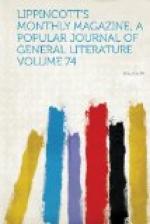In 1419, when they piled the stones of that wall, Christopher Columbus was not born, yet the basilica of St. Francis had been built more than one hundred and fifty years; and on such a June day as this the Asisinati leaned from their windows to see a Corpus Domini procession come up the street, just as they were now doing. It came through the fragrant silence and clear shadow like a vision. I could not restrain an exclamation of surprise and delight, for I had not dreamed of anything so beautiful. The procession would have been striking anywhere, but shut in as it was between the soft gray of the opposite stone houses, with the green-sprinkled street beneath and the glorious blue above, it was as wonderful as if, looking down into clear deeps of water, one should see the passing of some pageant of an enchanted city buried deep in the crystalline waves centuries ago. There was nothing here but the procession, leisurely occupying the whole street, treading out faint odors without raising a particle of dust. The crowd that in other places always obscures and spoils such a display here followed on behind. The leisureliness of an Italian religious procession is something delicious, as well as the way they have of forming hollow squares and leaving the middle of the street sacred to the grander dignities.
The members of the different societies wore long robes of red, blue or of gray trimmed with red, and had small three-cornered pieces of the material of the robe suspended by a string at the back of the neck, to be drawn up over the head if necessary. The arms of the societies were embroidered on the breast or shoulder, and each one had its great painted banner of Madonna or saint and a magnificent crucifix with a veil as rich as gold, silver, silk and embroidery could make it. There were the white camicie half covering the brown robes of long-bearded, bare-ankled Cappuccini, and sheets of silver and gold in the vestments of the other clergy.
Presently the canopy borne over the Host appeared, with the incense-bearers walking backward before it and swinging out faint clouds of smoke: the voices of the choir grew audible, singing the Pange lingua, and everybody knelt. In a few minutes all was over.




